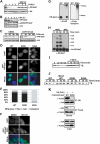Dynamic regulation of the PR-Set7 histone methyltransferase is required for normal cell cycle progression
- PMID: 20966048
- PMCID: PMC2975929
- DOI: 10.1101/gad.1984210
Dynamic regulation of the PR-Set7 histone methyltransferase is required for normal cell cycle progression
Abstract
Although the PR-Set7/Set8/KMT5a histone H4 Lys 20 monomethyltransferase (H4K20me1) plays an essential role in mammalian cell cycle progression, especially during G2/M, it remained unknown how PR-Set7 itself was regulated. In this study, we discovered the mechanisms that govern the dynamic regulation of PR-Set7 during mitosis, and that perturbation of these pathways results in defective mitotic progression. First, we found that PR-Set7 is phosphorylated at Ser 29 (S29) specifically by the cyclin-dependent kinase 1 (cdk1)/cyclinB complex, primarily from prophase through early anaphase, subsequent to global accumulation of H4K20me1. While S29 phosphorylation did not affect PR-Set7 methyltransferase activity, this event resulted in the removal of PR-Set7 from mitotic chromosomes. S29 phosphorylation also functions to stabilize PR-Set7 by directly inhibiting its interaction with the anaphase-promoting complex (APC), an E3 ubiquitin ligase. The dephosphorylation of S29 during late mitosis by the Cdc14 phosphatases was required for APC(cdh1)-mediated ubiquitination of PR-Set7 and subsequent proteolysis. This event is important for proper mitotic progression, as constitutive phosphorylation of PR-Set7 resulted in a substantial delay between metaphase and anaphase. Collectively, we elucidated the molecular mechanisms that control PR-Set7 protein levels during mitosis, and demonstrated that its orchestrated regulation is important for normal mitotic progression.
Figures






References
-
- Biron VL, McManus KJ, Hu N, Hendzel MJ, Underhill DA 2004. Distinct dynamics and distribution of histone methyl-lysine derivatives in mouse development. Dev Biol 276: 337–351 - PubMed
-
- Congdon LM, Houston SI, Veerappan CS, Spektor TM, Rice JC 2010. PR-Set7-mediated monomethylation of histone H4 lysine 20 at specific genomic regions induces transcriptional repression. J Cell Biochem 110: 609–619 - PubMed
-
- Fang G, Yu H, Kirschner MW 1998. Direct binding of CDC20 protein family members activates the anaphase-promoting complex in mitosis and G1. Mol Cell 2: 163–171 - PubMed
Publication types
MeSH terms
Substances
Grants and funding
LinkOut - more resources
Full Text Sources
Other Literature Sources
Molecular Biology Databases
Research Materials
Miscellaneous
